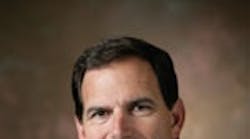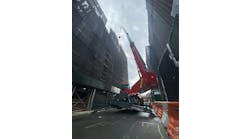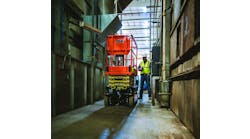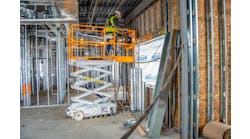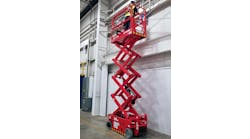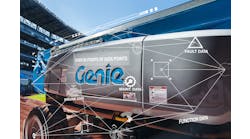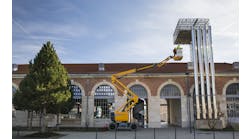Oshkosh Corp.'s Wilson Jones recently took over as president of JLG Industries, taking the place of retiring Craig Paylor. RER recently sat down with Jones, who spoke about his vision for the aerial industry, the importance of rental, international growth and aftermarket support, the performance of JLG in manufacturing military vehicles and how his golf game compares with Paylor's.
RER: What are your primary goals with JLG?
I just got back from a two-week trip through Europe where a few people asked me “Tell me about your strategy” and I said, “I'm afraid if I told you about my strategy you'd think ‘here comes this new guy, he thinks he knows everything.’” I'm learning every day here, it's a new industry for me. I've got a great team here that's coaching me along the way.
If you look at JLG — and I was on the Oshkosh team when we made the acquisition and got to know some of the guys back then — it's quite a tradition that they built here with the cream and orange, going back to John L. Grove. One of my main goals is just to continue to build on that tradition. JLG has a great reputation in the market place as an innovator, as a great supporter of its products, taking care of the customer after the sale. Those are the fundamentals that you always want to have in a business and to build on.
My track record has always been about growth, taking companies that have really been working hard and trying to grow them, sometimes through acquisition but primarily through organic growth. So that's what I've been studying, really looking at the model. The JLG team has for several years been looking at the model and challenging it, asking is it time to change the way we do business, with the primary objective of making sure that the customer is at the center of our model no matter what we do.
Businesses a lot of times plateau; they don't challenge themselves. I like to say to get what you've never had you must do what you've never done. That's what we've done in the past and that's what we'll continue to do here. Craig set the mark; there's been a lot of good leadership here over the years. So a big part of my role is to challenge the organization, make sure we don't become status quo. In North America, in Asia Pacific and Europe, I'm hearing that from the customers. They're asking, “What are you going to do? What's JLG going to do that's different, that's value-added to us?”
We do strategy deployment throughout Oshkosh; basically a 3-year plan. That's in place. I guess I'd be a little nervous about saying what specifically we're doing because there are some objectives that are new and I definitely want to stay ahead of our competition. They'll figure it out fairly soon I'm sure, but emerging markets are a big area of focus. Continuing to work and challenge ourselves to be the best lifecycle management company out there from an aftermarket standpoint. The new product development's got to be there. Right now unfortunately JLG's had to hit the pause button a little bit for two reasons: the economy and all the engine installations, changing emissions. A big part of our new product development today is going to gear up to Tier 3 and Tier 4 engines. You'll see a couple of new product introductions at ConExpo this spring.
The company has been developing in China. Can you tell me a bit more of what's happening around the world?
We've made a significant investment in China, with a brand new facility there. We've got two scissor lines up and running and we just started building 60-foot and 80-foot booms. We've got some opportunities in China, with educating the market, with the development of government regulations to make the workplace safer. There's going to be a lot of education involved in China.
To skip around the globe, every market we had in the third quarter was up year over year and I don't think JLG has been able to say that for about two years. So that was a nice step. The fourth quarter will be strong for us.
I'll talk about Brazil, that seems to be the hottest market right now, and we're looking at some different alternatives there. It's probably been percentage-wise our biggest market for growth this past year. Several of our competitors are there just like us, surveying and figuring out what kind of footprint we all need in Brazil. We have had some success in other countries in Latin America but I would say Brazil is the big one.
Jumping over to Asia Pacific, Australia continues to perform well for us, we're in India now with two sales and services offices, both of those showing good progress. We're looking at other ways to serve India, obviously a giant market, a lot like China, not as up to speed or educated yet on product.
We're cautiously optimistic that Europe will pick up some, but it's going to be a very slow recovery. We have had an uptick in North America, I think a lot of that is replacement fleet, probably the better news there is most of the big rental fleets are talking about raising their capex for next year simply because their fleets are aging.
Are there particular types of aerial equipment that you expect to see more emphasis on in the coming years?
Well, you never want to take your eye off the bread and butter, the core of your business. So we'll continue to do that and expand those products, but there are some needs out there for some niche products. We've got some of that. As you know our LiftPod is gaining momentum, we're excited about that. We've got a new version of LiftPod that we're going to be introducing soon, it's a version that basically will fit through a standard door. So we're expanding that opportunity. There's more stuff going on in the industrial side today, I'd say shipbuilding has picked up some. There are other niche products that we're looking at studying, so you'll see some more of that coming out of JLG.
Is the Liftpod growing in acceptance in the marketplace?
It is, and what's growing is the excitement in distribution. I met with two key customers in Europe and they shared with us some direct marketing things they are doing that are going to help the Liftpod gain acceptance. As you know, with a product like that going against the tradition of, say, a ladder, it's going to take some excitement from more people than just us. So it's nice in my short time here to hear that distribution is getting more and more excited about it.
Obviously much of JLG's success has come from the rental business in North America. Is the rental industry in North America going to continue to be a significant part of JLG's business or will JLG be forced to diversify into other areas because of the slump in the North American construction business?
I think rental will always be a big part of what we do at JLG. We're counting on rental coming back and growing in a much bigger way over the next several years, but we're looking at some other things, from products to geography, kind of across the board. I wouldn't call it a diversification strategy; I would call it a growth strategy.
The sales to the military have increased a great deal for JLG and obviously the relationship between JLG and Oshkosh has had a lot to do with that, with Oshkosh's history in that area. Can you tell us some more about that military business?
JLG did $3 billion in 2008, $1 billion in 2009, a significant drop. That's tough for a company to go through. And Oshkosh receiving the M-ATV award and then allowing JLG to build the capsule and close to 3,000 of the completed vehicles enabled JLG to bring back over 600 of the employees that were reduced during the downturn. JLG performed flawlessly in this, and Secretary Gates was quoted as saying this is one of the fastest buildups of a new vehicle in military history. It went from start to finish in about a year and produced 10,000 vehicles to help our troops stay out of harm's way, and JLG was a big part of that delivery.
JLG did a lot of things, getting people back to work, which is always a key thing, but because they performed so well, now Oshkosh certainly looks at JLG as a company that is multi-purpose; able to do a lot of different things and do them well. They never really built complete vehicles like that here. So what is opening up for us are other opportunities and Oshkosh needs capacity. Foreign military sales for the M-ATV can drive some more business for JLG. And during the cycles that we go through, that business has been really good for JLG this past year.
You might find yourself with the more traditional business growing and at the same time the military business growing.
That's right. And I was telling a couple of the big rental leaders on this past trip, it was nice to see JLG go through this because if you think about it, it was somewhat of a dress rehearsal for the upturn. You know how fast things can come back in this industry and to ramp up in one year and then deliver 10,000 vehicles, a combination between here and Oshkosh, we had to be close to our supply chain. So now we've been through that dress rehearsal and I can tell you our materials team here is well engaged with our supply chain. And I believe in having those good conversations, good understanding and objectives so when things do pick up, we have a good relationship built with the supply chain.
It may not ramp up as fast as in the past.
I think that's true, but the supply chain didn't go down this far in the past either so even coming back 20, 30 or 40 percent, will still have challenges because they went down so low.
Tell us a bit more about yourself, Wilson, about your background, professionally, educationally? What are some of the unique qualities you bring to the table with JLG that we may not know about?
As you can tell by the way I talk, I'm not from here. I grew up in Texas, and went to school at North Texas State, which is University of North Texas now. After college I went to work in the bus business and spent about nine years with Bluebird. Maybe at some point in your life you rode in a Bluebird school bus, most of us have been in one at one time or another. I worked in specialty vehicles: started with buses then went into ambulances and fire trucks and that's how I ended up with Oshkosh. I had been with Emergency One, a competitor of Pierce, which is Oshkosh's big fire truck company. We built aluminum aerials, ladders, and ladder trucks with aluminum aerials on them. When a lot of people in that industry were saying that won't work, we figured out how to do it, and it really put Emergency One as the leader in fire apparatus.
So the sales and marketing side of the business charges me up, I enjoy it. I learned to like all the disciplines of the company, but sales and marketing is where I really gravitated. Working with distribution, nearly every business I've been in has been a relationship-based business.
If you take care of the customer you take care of everything else, that's something I learned at a very young age. The last five years I've been running Fire & Emergency. Oshkosh has four segments, we've got commercial, which is the refuse truck and concrete placement group; we got defense, I know you're aware of Oshkosh's defense group; we've got Access, which is where we are today, and the fourth segment is fire and emergency, we have nine companies within fire and emergency. It was a different model in managing nine different brands, all with separate distribution channels or different types of distribution.
Going from kind of a wide and shallow group to a more complex single-brand company, there are some differences. I worked a couple of years with the airport business unit; spent a lot of time growing it internationally, with all the buildup of airport structure as they got ready to accommodate the A380, the new airbus.
I drew a lot of opportunities for our airport rescue fire-fighting vehicles so we went into the Middle East with the products, we went into places like Taiwan, Vietnam, a lot of places where no one else in North America at the time was going. So I got credit for leading some international growth for the corporation. It was a team effort; I'll be quick to say that. I got to lead the team that went into all those places. But it was a lot of fun, I learned a lot about the value of understanding each market, they all are different. Then this opportunity came up.
You've worked closely with Craig Paylor at JLG?
Craig and I got to be good friends; we'd share some of our customer events. I'd have an event and he'd bring a couple of customers to it, or he'd have an event and allow me to bring a couple of fire chiefs to it, so I got to know Craig over the years. When all this came about, I was certainly honored they would consider me for this role, access is a bigger segment than fire and emergency.
Craig is still coaching and mentoring me a little bit. He was on the trip to Europe with me and I tried to stay as close to him as possible, he's been very generous with his time with me.
Is there anything you can point to that would explain any different emphasis that you might have compared with Paylor, who is well known to our readers and the people of this industry?
I think Craig and I are similar, he's certainly a sales and marketing guy. Obviously I don't have the “Mr. JLG” tag that he's got, and it's well-deserved in his case. We're a lot alike in the way we build relationships. Like Craig, I believe in knowing the customers and traveling — I know he was a big proponent of that. He and I both have a lot of similar views on aftermarket; that it's a key issue for a company to be very involved in aftermarket. You know life cycle management, you don't allow other people to have those types of relationships with your customers, you're with them cradle to grave. I'd say we're very similar in our thinking. I can't think of anything that we're real different about other than he's got a real good golf game and I don't.
We're both very competitive; we shared a lot of business stories. Some of the things he brings up, it's like we're playing the same game, just with different color jerseys.
What are your expectations for the economy?
We read a lot of information and then we talk to a lot of customers, there's a lot of replacement that is being debated now. We'll have an increase next year over this year. I think the better we do in some of these emerging markets will determine how much of an increase.
The aftermarket service component continues to be an important area of the aerial business. What are your plans to develop and expand the services of JLG Ground Support?
We continue to invest in ground support around the globe. That will continue. I think aftermarket is one of those areas where we're really talking a lot to the customer base, there may be some other things we should be doing. When we talk about the model today, are there opportunities to make the model better, you have to look at aftermarket.
What are some potential untapped or underserved markets for aerial equipment — geographically and in terms of industries where aerial equipment's penetration has a lot of room for growth? I wonder if being somewhat new to this industry you might have some fresh insight.
There are some other synergies that we can work with other companies just within Oshkosh to grow product lines, to come up with some hybrid-type products together with another Oshkosh company. I'm really excited about that potential and having been in charge of another segment coming to this segment, I call it just making sure we're exploring all other opportunities; I think that definitely is here and we're having a lot of those discussions today.
